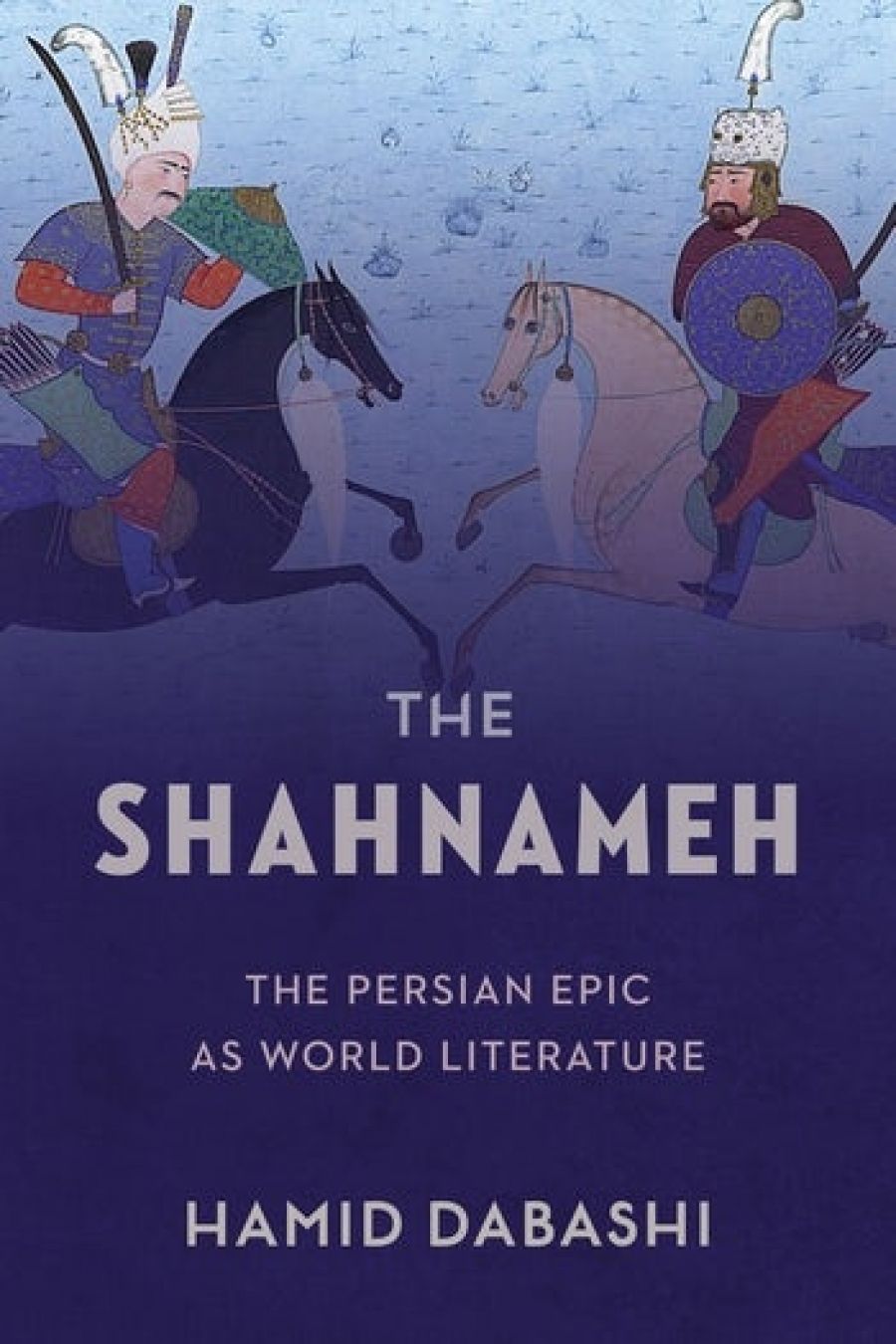
- Free Article: No
- Contents Category: Poetry
- Review Article: Yes
- Online Only: No
- Custom Highlight Text:
Not many peoples are able to read poems in their language written one thousand years ago, as Persian speakers in Iran, Afghanistan, and Tajikistan do today with Ferdowsi’s Shahnameh, meaning the ‘Book of Kings’. The Shahnameh is Iran’s national epic, a vast compilation of pre-Islamic Iranian myths, legends, and imperial history ...
- Book 1 Title: The Shahnameh
- Book 1 Subtitle: The Persian epic as world literature
- Book 1 Biblio: Columbia University Press (Footprint), $68 hb, 272p, 9780231183444
Another unique aspect is identified by Shahnameh expert Mahmoud Omidsalar: ‘Unlike other classical Indo-European epics,’ he writes, ‘the Shahnameh is not in a dead language. It is intelligible to every speaker of Persian in Iran, Afghanistan, and Central Asia.’ For his colleague Hamid Dabashi, professor of Comparative Literature and Iranian studies at Columbia University, the Shahnameh is remarkable because, though canonical, it is not antiquated but alive and accessible. As Dabashi writes, it is ‘generation after generation, memorized, performed, painted, praised, critically edited, and even revered’. This reverence abides, despite Persian speakers already having the revered, spiritual works of Hafez, Rumi, Omar Khayyam, Attar, and Sa’di. Unlike those works, we find little explicit Sufism or Islamic mysticism in the Shahnameh.
Hamid Dabashi has a twofold aim in The Shahnameh: The Persian epic as world literature. The first, carried out in the book’s early chapters, is to present the epic poem to Western and non-Persian-speaking readers, who are unlikely to know Ferdowsi well. Dabashi wants to arouse passion for the Shahnameh, to show how it can be read, to interpret the text for present-day circumstances, and to ‘wonder at its magic’. His decades of classroom experience teaching the epic sustain him here, allowing him to explore its subtleties. In these chapters, there is much worthwhile material covered regarding the Shahnameh’s creation, Ferdowsi and questions of authorial intent, stories, characters, the poems’ predecessors, and its cultural significance in Iran and globally. Dabashi’s ardent style and voice can be charming, and excessive.
A central concern is to staunchly defend the Shahnameh’s self-sustained aesthetic and moral power as a world unto itself, one established and justified by imaginative creative power and not an external political theology. Accordingly, Dabashi criticises many political usages of the epic in projects of ideological construction, where the poem is ‘symbolically iconicized and massively instrumentalized’, thereby destroying its polysemic richness. Though sometimes repetitive in these criticisms (with some unfortunate instances of academese), such critiques of the narrowness of nationalist myth-making are Dabashi’s strong suit. Overall he mounts a strong analysis of the Shahnameh as a ‘master signifier’ of narratives of state-sponsored Iranian modernity.
 Hamid Dabashi (photograph via Columbia University)
Hamid Dabashi (photograph via Columbia University)
The story of the Shahnameh thus becomes, in Dabashi’s mind, the story of how emerging modern nation-states use native literature, especially epics, to imagine themselves from ancient empires to post-colonial polities. For Dabashi, this is problematic for a non-European country like Iran because ‘the origin of linguistic and literary nationalism, as the political and ideological source of state-building projects, is deeply rooted in European colonialism’. Here, Dabashi attacks what he claims are Eurocentric literary, temporal, and spatial categories (for instance, the division between ancient, medieval, and modern periods), which have been inappropriately applied by academics to the Shahnameh. He argues that such inapt categorisation distorts and ‘deworlds’ the qualities of many works ‘and forces them into an obedient servitude to European historiography’. Dabashi’s second aim is therefore to stage a re-conception of the category of ‘world literature’, insisting that the current framework is unable to deal meaningfully with texts such as the Shahnameh. This fits in with his earlier exposition of the epic’s majestic distinctiveness as a literary work, ‘neither an epic of conquest nor an epic of defeat but an epic of perpetual, historical defiance’, achieved in part by examining the Shahnameh against epics like Virgil’s Aeneid and Homer’s Odyssey. Dabashi’s project is thus one of demolition (or, in Heideggerian terms, a destruktion), dismantling the inadequate prevailing conceptions of ‘world literature’ to rebuild a new understanding able to incorporate maverick, non-European works like the Shahnameh, establishing them in their proper place and ‘on an equal footing for a renewed global reading’.
The two disparate streams in Dabashi’s book – the poem’s analysis and celebration on the one hand, and the academic dispute on the other – while related, take the book in different directions, and the academic material on ‘world literature’ may not be to the taste or patience of some general readers, who will still gain much from Dabashi’s introductory expositions. Regrettably, Dabashi at times uses stylistic language that is excessively rhetorical, instead of letting his arguments do the work. Stricter editing should have cleared up these elements, while preserving something of Dabashi’s garrulous, vigorous style. These issues notwithstanding, for those who wish to deepen their understanding of Persian poetry and literary history, The Shahnameh: The Persian epic as world literature makes a worthy companion to the English translation by Dick Davis. Marrying passion and scholarship, Dabashi reasserts the place of this beloved and foundational epic, ‘composed’, he writes, ‘in Persian with poise, patience, perseverance, as if performing an act of poetic piety, of moral obligation, of the ritual ablution of a people’.


Comments powered by CComment